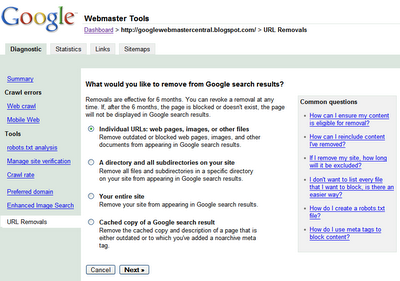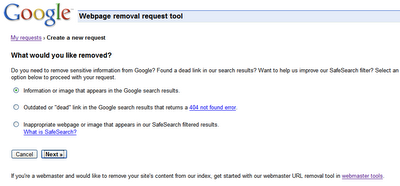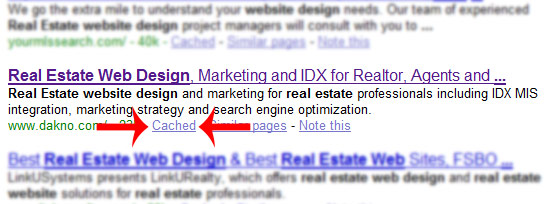I have seen many real estate agents in this scenario. They leave one real estate company and join another firm or start their own company. When this happens, real estate agents go through the typical song and dance. They update marketing materials, Web site information, etc. Even if a real estate agent hits all the highpoints of their Web site (footer information, contact information, etc.) their old information can still permeate throughout the internet long after they are settled into their new surroundings.
Eliminating the Footprints of Your Past
This could be a serious problem on two levels. First, Google may be sending traffic to your former real estate company. And second, your former real estate firm may cry foul because they think you are continuing to represent yourself as being tied to the company. The reality is that even if you update your Web site information, there still could be dozens of places online that have your old information. The bad news is that for some of these places, it may be nearly impossible to remove your former ties to your old real estate firm. With that in mind, I thought it would be helpful to point out a few ways to try to eliminate as many foot prints as possible.
Your Real Estate Career is Hiding in Many Corners of the Web
Before we dig too deep into these hidden areas, we need to take a quick look at the obvious places. This is because many times, people think they have eliminated all of their old references to their former real estate company. But keep in mind, there are lots of corners of websites where the information can easily hide.
Smarter Searches Means Better Results
The very first step is to see how much information is out there that references you and your former real estate company. A few simple searches will quickly reveal how much of an uphill climb you will have. Start out by searching your name (in quotes with your former real estate company name. For example: “John Doe†Acme Real Estate Company or “John H Doe†Acme be sure to try various combinations. If you have a common name like “John Smith†try to add in a local reference such as “John Smith†Raleigh Acme. Another helpful tip is to search for your old office phone number (if you had a dedicated office line).
Check Your Own Website
Although you may think that you have already eliminated all the references to the old information, it’s still best to double check. Again, you can use Google to help you out with this. Let’s say that your former real estate company name was “Acme Real Estate Company.†Simply go to Google and search for “Acme Real Estate Company†site:yourdomain.com. This tells Google to search for the phrase Acme Real Estate Company but limit the search to only yourdomain.com. The advantage to this search is that it not only searches all of your pages, it also searches many other files types that may exist on your Web site (Power Point Presentations, PDF files, Word Docs, etc). Be sure to search for different variations of the company name (Remax, RE/MAX or C21, Century21, and Century 21).
Just Update The Information
After you have found the outdated content, it will just be a matter of updating these rediscovered Web sites. Typically, this is a simple issue of revisiting all of those Social Networks that you sign up for but never got around to actually using. Using the searches described above, it is pretty easy to identify these abandoned social networks sites and tweak your profile with the updated content.
Hey, I didn’t Even Submit This Information!
Ahh the good old scraper sites. There are plenty of web sites out there that do nothing but scour the intent looking for content. They then harvest the content and add it to their site. Some of these are nothing but spam sites looking for any type of content that they can show in between the gobs of ads! The reality is that these sites don’t play by the rules. Contacting these sites will do nothing but tell them you have a live email address that is ready to be spammed! Don’t even contact them, they are not worth it. However, there are a few legitimate Web sites that use this approach. One such Web site is ZoomInfo. They spider the internet looking for references to businesses and people. They translate this information into company information. Here is the kicker. Sometimes the information is accurate and up-to-date. But other times, it’s old and out dated. Many of these Web sites such as ZoomInfo.com allow you to “claim your profile.†However; even then, it may still be difficult to update this information. This is because the system has to first determine that you have the right to make changes. If none of your contact information matches (which could be the case if you move offices) then extra steps may have to be taken to prove you have the right to update that information.
The Online Phone Book – Your Worst Enemy
Of all the contact information floating around the web, one of the hardest to change is content that has been harvested from yellow page information. Local Search Sites and IYP (Internet Yellow Pages) are often extremely slow to update information. And because the data is directly from yellow page listings, they feel the data is reputable. In addition, these Web sites are often the product of larger conglomerates making it even more difficult to the source to where the updated information has to be submitted. Even worse, many times, these companies will simply add your new listing instead of replacing the existing information. This then will leave you with two different listings with conflicting information (and giving you another hurdle by giving a 50/50 change of them removing the correct listing). The best option is to simply play by their rules. Jump through the appropriate hoops and wait (often 60-90 days) for the change to take place. Fortunately, a few Web sites that have used yellow page information are quickly discovering that their data is anything but 100%. With this in mind, Web sites such as Google Local are giving more ability for the public to update the information. You now can request removal of old, out-dated information. Let’s just hope that more Web sites pick up on this concept!
Updating Your Link Love
More than likely, your Webs site has established links through the years of building your online presence. Keep in mind that many of these sites may reference your old company information when linking to your Web site. Again, the best place to find these sites is to start at Google. Simply type link:domainname.com. This will give you a list of some of the top Web sites that link to you. Unfortunately, Google does not allow keywords to be combined with a link: search. This means that you will need to scan each website that links to you to ensure they have correct information. While the link: search will get you started, it is not a full list of all of the Web sites that link to you. To see a full list, I suggest using Yahoo Site Explorer or Google Webmaster Console. But be prepared. The number of people linking to you could be substantial and not all of the Web sites will still be maintained. This means that you may have to live with the fact that some of these abandoned Web sites will forever contain your old contact information.
Work With the Site Owner
The best and often quickest way to get the content removed is to work directly with the site owner. Many times, a simple email stating the problem will lead to a quick resolution. When contacting the site owner/webmaster/etc. be sure to communicate the urgency of the matter without being demanding.
I See it in the Search Results, But it’s Not Really There!
A common issue is that although you have removed the content, it still shows up in Google cache. To verify that this is the case, first click on the link and search (control + F) the keyword. If you can’t find the keyword, hit the back button to return to the Google Search Results. This time, click the cached version link. Chances are that you will see that Google’s local copy of the site still has the information, even though it has been removed. But don’t worry; there are ways to force Google to update this information.
Google Cache – Websites That You Own
Google Cache – Websites That You Own
Google actually makes it very easy to eliminate cached information on Web sites that you own. If you haven’t already, you will first need to sign up for Google Webmaster Tools. Once you have signed up, simply click on the URL Removals link under Diagnostic.

Google Cache – Websites That You Do Not Own
Okay, so what happens if you have updated the information on Web sites that you do not own (such as social network sites, etc) yet Google is still showing the old information in their cache? If that is the case, then you will need to use this removal form to request removal of the cached information. Just note that this will not be instant and just because you ask, there is no guarantee that Google will comply. After all, the content is on a 3rd party website and it may not be easy for Google to verify that you have rights to that content.

If you need even more information on removing content from Google, I suggest you read this post from the Google Webmaster Blog or reference the help page on removing content from Google’s index. Many of the solutions involve editing code so I suggest seeking the help of an experienced web developer. After all, this isn’t something that you want to take a chance on!
Give Google a Reason to Crawl Your Web Site
Many times, Google still has old information because they simply do not see the value in revisiting your the Web page. Google has no desire to frequently visit sites with duplicate content, dated information, or bad code. With this in mind, take a moment to freshen up your content. This will get the search engines interested again thus replacing your old, outdated content with the fresh content you want Google to see. When using this approach, be sure to help Google out by linking to the content. This makes it easier for the engines to find your updated pages.
Old Information in the Open Directory Project
There is another scenario where Google may show old information in the search results, despite having updated information in the cache. Many people don’t realize that Google and other search engines may sometimes use the title from DMOZ.org (The Open Directory Project) as your title in the search results. This means that for particular searches, search engines may elect to show your Open Directory Project (ODP) title instead of your updated title tag. The solution? First, go to DMOZ.org and search for your name or domain name. Click on the category that includes your listing and then click “Update Listing†in the top right corner. Fill in the updated information and submit. Just keep in mind, the ODP is human edited. This means that it may take weeks or even months before one of the volunteer editors gets around to making the requested change. Need a quicker fix? Just tell the search engines to not use the title from the ODP. To do this, simple add <meta name=â€robots†content=â€noodpâ€> to the head of your HTML. This will tell search engines to use the title tag on your website and not the title from the ODP.
Add Private Eye to Your Resume!
As you can tell, removing references to your old real estate firm is a large task that provides detective like resources and a lot of waiting. And even then, there is no guarantee that Web sites will comply. The reality is that the internet is largely out of your control. You can ask, but it doesn’t mean other sites will comply. Furthermore, many sites may be abandoned and thus there is no one to even contact to update the information.
It’s Not Easy to Erase Your Past from the Web!
One more thing to note, this information simply covers tips for removing some of the more prominent sites that reference current information. It’s next to impossible to erase all traces of the information. In fact, Web sites like archive.org keep a running tab of almost every site’s change for the last 10 years.
Has It Happened to You?
Have you thought about this happening in your world or have you faced this situation before? Leave a comment and briefly share your experience.
Brad
 your other subscriptions
your other subscriptions



Brad, thanks I changed to Keller Williams in Dec and even though I changed many I still find stuff after being with remax for 11 years.
Brad – It’s been over 2 years since I left Coldwell Banker and I still find sites with that information. I have tried to have a few updated with little luck but since it does point to my website I just let it go. It really is a battle to keep it all updated though. Good tips thanks!
Brad, I see stuff from a company that I was with 3 years ago, thank you for this invaluable info. The tip on updating content is also appreciated.
Brad, great timing, changed brokers earlier this year and have been working to update – so as always, thanks for sharing your info and tips.
Thanks Brad! Kathryn and I changed/upgraded last August and it was quite a chore to change as many references as we could. Using your tips I found a few more places to go to update our information. I see it as a good opportunity to upgrade those links using better anchor text, descriptions, etc.